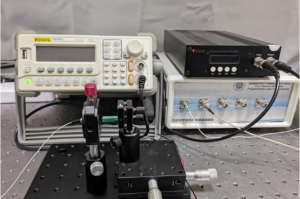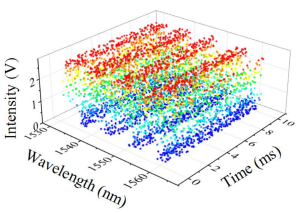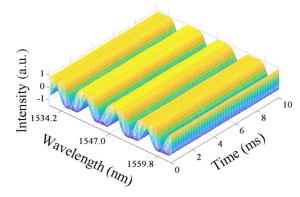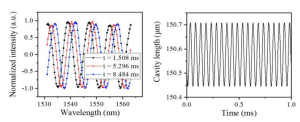Experiment name: Application of power amplifier in absolute measurement of micro-vibration of optical fiber white light interference
Research direction: Interference optical fiber vibration sensing. This paper proposes a fiber white light interference dynamic measurement technology (CS-WLI) based on the principle of compressed sensing. The time-varying interference spectrum of a Fabry-Perot vibration sensor is considered a two-dimensional (2D) signal with respect to laser wavelength and time and can be compressively sampled using a programmable semiconductor laser during the measurement process. The spectral sampling rate after CS reconstruction is equal to the random wavelength modulation frequency. Nanoscale vibration experiments verified the effectiveness of this solution.
Test purpose: to verify the effectiveness of the proposed compressed sensing optical fiber white light interference technology and achieve high-precision all-fiber vibration monitoring.
Test equipment: signal generator, SLA-5-25 power amplifier, piezoelectric ceramic transducer, programmable fiber laser interference demodulator, etc.
Experimental content: A low-precision Fabry-Perot interference cavity is formed between the fiber end face and the piezoelectric ceramic pasted with a gold mirror. The sinusoidal signal generated by the signal generator is amplified by the Antai Electronics SLA-5-25 power amplifier and then loaded onto the piezoelectric ceramic transducer, driving the piezoelectric ceramic transducer to vibrate at high frequencies. Different from the linear wavelength scanning of conventional optical fiber white light interference, this scheme controls the programmable laser to perform random wavelength sampling, reconstructs the interference spectrum of each sampling point through the compressed sensing reconstruction algorithm, and then demodulates it to obtain a Fabry-Perot interferometer. The absolute cavity length.
Experimental process: As shown in Figure 1, the signal generator outputs a sine wave signal with a frequency of 20kHz, which is loaded into the piezoelectric ceramic transducer after passing through the SLA-5-25 power amplifier, and drives the piezoelectric ceramic transducer to generate a sine wave signal of the same frequency. vibration. With a wavelength switching speed of 500 kHz, the modulation grating Y-branch laser is rapidly and discretely modulated according to the random wavelength sequence built into the laser driver module, and the corresponding interference light intensity is collected simultaneously. Compressed sampling interference spectrum data collected over a period of time is shown in Figure 2.


Test Results:
Based on the principle of compressed sampling, the spectral data collected in Figure 2 are reconstructed to obtain the two-dimensional spectrum changing with time in Figure 3. A complete reconstructed spectrum can be obtained at each sampling time point. Figure 4 shows the reconstructed interference spectra at three time points. Through this interference spectrum and the conventional white light interference cavity length demodulation algorithm, the absolute cavity length of the Fabry-Perot cavity can be obtained. The cavity length waveform is shown in Figure 5. This solution can realize all-fiber, non-contact high-frequency vibration measurement, apply the principle of compressed sensing, and greatly increase the spectral sampling rate.


The performance of the SLA-5-25 power amplifier in this experiment: driving piezoelectric ceramics to generate vibration signals.



